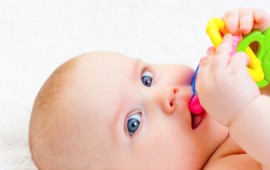Helping Your Baby Through The Teething Process
Author: Shannon Miller Lifestyle

When a baby begins to go through the teething process it can be very painful for them and very frustrating for you as a parent trying to provide some relief.
Most babies usually start teething around the age of 6 months. Typically, the two lower front teeth will come in first, followed by the two top front teeth.
Classic signs and symptoms of teething can include:
- Drooling, which may begin about two months before the first tooth appears
- Irritability or crankiness
- Swollen gums
- Chewing on solid objects
Researchers say that teething symptoms will occur in the mouth, but should not show up anywhere else in the body. So, fevers or diarrhea are not signs of teething as many parents often think.
Here are a few great remedies to help soothe those sore gums and help your baby feel more comfortable.
1. Rub your baby’s gums. Use a clean finger, moistened gauze pad or damp washcloth to massage your baby’s gums. The pressure can ease your baby’s discomfort.
2. Offer a teething ring. Try one made of firm rubber. The liquid-filled variety may break under the pressure of your baby’s chewing. If a bottle seems to do the trick, fill it with water. Prolonged contact with sugar from formula, milk or juice may cause tooth decay.
3. Keep it cool. A cold washcloth or chilled teething ring can be soothing. Don’t give your baby a frozen teething ring, however. Contact with extreme cold may hurt, doing your baby more harm than good. If your baby’s eating solid foods, offer cold items such as applesauce or yogurt.
4. Dry the drool. Excessive drooling is part of the teething process. To prevent skin irritation, keep a clean cloth handy to dry your baby’s chin. You might also make sure your baby sleeps on an absorbent sheet.
5. Try an over-the-counter remedy. If your baby is especially cranky, acetaminophen (Tylenol, others) or ibuprofen (Advil, Motrin, others) may help. Don’t give your baby products that contain aspirin, however, and be cautious about teething medications that can be rubbed directly on a baby’s gums. The medication may be washed away by your baby’s saliva before it has the chance to do any good — and too much of the medication may numb your baby’s throat, which may interfere with his or her normal gag reflex.
If you haven’t already been doing so, begin running a clean, damp washcloth over your baby’s gums everyday. This can help keep the bacteria from building up in your baby’s mouth.
When you see those first little teeth pop in, use a soft-bristled toothbrush without toothpaste. Water is all you need until your child learns to spit, which usually happens around age 2.
This is the time to start thinking about regular dental checkups. The American Dental Association and the American Academy of Pediatric Dentistry recommend scheduling a child’s first dental visit after the first tooth erupts and no later than his or her first birthday. Your baby’s teeth and gums will also be examined at well-baby checkups. Regular childhood dental care is very important and can also help teach your child the importance of taking care of their teeth.
Source: mayoclinic.com/
